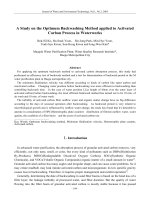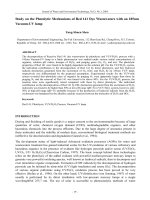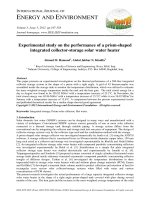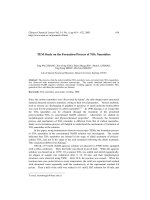To study on the applicability of biofuel for the small marine diesel engines in Vietnam conditions
Bạn đang xem bản rút gọn của tài liệu. Xem và tải ngay bản đầy đủ của tài liệu tại đây (714.91 KB, 5 trang )
KẾT QUẢ NGHIÊN CỨU VÀ ỨNG DỤNG
TO STUDY ON THE APPLICABILITY OF BIOFUEL
FOR THE SMALL MARINE DIESEL ENGINES
IN VIETNAM CONDITIONS
Nguyen Duc Hanh1*, Nguyen Đai An2, Đang Van Uy3
Abstract: At present time, the climate change has been effecting over world. The International Maritime Organization through the Annex VI of the MARPOL 73/78 Convention strongly requests the all Governmental
Parties to take a part in the reduce the emissions from their fleet to the atmosphere. Therefore, Vietnam Maritime Universty is to carry out a research on using the crude palm oil for the marine diesel engines equipped
on board of inland waterway ships. The crude palm oil means the pure palm oil which is not transesterified
(It is not 3 fatty acid methyl esters). The research has to answer the following questions: Whether we can
use the crude palm oil for marine diesel engines? Which percent of the crude palm oil should be mixed
with the DO that the mixed fuel do not harm to the technical and economical features of the marine diesel
engines; How much we can reduce the exhaust gas emissions from the ships when we use the mixture fuel
for the marine diesel engines in Vietnam.The research started since 2010 at Vietnam Maritime University
facilities and a sizable number of experiment has been done. As the output of research, positive result at
the considerable reduction of engines exhaust gas emissions has been obtained. The paper is discussing
on the methodology and possibility of using crude palm oil for diesel engine of in-land water fleet in Vietnam
and the obtained result as well.
Keywords: Climate change; emissions; MARPOL 73/78 convention; biodiesel; Vietnam Maritime University;
crude palm oil; in-land water fleet.
Nhận ngày 10/5/2017; sửa xong 9/6/2017; chấp nhận đăng 23/6/2017
Received: May 10, 2017; revised: June 9, 2017; accepted: June 23, 2017
1. Introduction
In Vietnam there are more than one hundred thousand transportation means equipped with diesel
engines as main power units [1]. Yearly, these diesel engines use a million tons of diesel oil and also discharge
to the environment a lot of toxic emissions that cause pollution to the atmosphere and make the sea level higher
[4]. There are many ways to overcome this problem, but in this article we will introduce our research on using
crude palm oil and blends as alternative fuel for marine diesel engines.
2. Biodiesel as alternative fuel for diesel engines
The very first diesel engine which was invented by famous engineer Rudolph Diesel, ran on peanut
oil in 1905, but thereafter, the increased cheap supply of crude oil totally replaced the use of the fuel produced from vegetables. However, at present time due to the higher price of the crude oil and high pressure of
pollution to the environment, many countries have found the solution based on using the fuel that produced
from the agricultural products and from the animals fast.
In the past time, the fuel that made from vegetable was taken a name based on the name of the
agricultural product such as peanut oil, sunflower oil etc. Nowadays, the vegetable oil used as a fuel for
diesel engines is commonly named as biodiesel. Basically, biodiesel may be made from the pure vegetable
oil (soybean, palm, sunflower…) and rendered animals fats or waste cooking oil. To obtain biodiesel, the
oil must be passed through a chemical process so called “transesterification”. After the process, glycerin is
removed as a byproduct, and the final Methyl Ester can be blended with fossil diesel oil or used directly as
alternative fuel for the diesel engines.
ThS, Trường Đại học Hàng hải Việt Nam.
PGS.TS, Trường Đại học Hàng hải Việt Nam.
3
PGS.TSKH, Trường Đại học Hàng hải Việt Nam.
*Coresponding author. E-mail:
1
2
58
TẬP 11 SỐ 4
07 - 2017
KẾT QUẢ NGHIÊN CỨU VÀ ỨNG DỤNG
The effects of replacing fossil-based fuel with biodiesel much depends on the inherent properties of
the fuel and diesel engine operating principles. A comparison of the properties between fossil-based diesel
oil and biodiesel is as shown in Table 1.
Table 1. The diesel oil and biodiesel properties
No
Fuel properties
Fossil-based diesel oil
Biodiesel
0,86-0,90
0,82-0,845
1
Density, 15oC (g/cm3)
2
Viscosity at 40oC(mm2/s)
3,5-5,0
2,0-4,8
3
Lower heating value (MJ/kg)
45,218
36,782
4
Flash point, C
60-80
100-170
5
Sulfur content, S (%)
0,05 max
0-0,00024
6
Carbon content, C (%)
87
77
7
Hydro content, H2 (%)
13
12
8
Oxy content, O2 (%)
0
11
9
Water content, (%)
0,05 max
0,05 max
10
Boiling point, oC
180-340
315-350
11
Cetane number
40-55
48-65
12
Lubrication ability, SLBOCLE (g)
2000-5000
>7000
o
Recently, biodiesel is being used widely in
Europe, United States and Brazil for diesel engines
equipped in the shore transportation units, but it
is still not so popularly used for the marine diesel
engines, because the price of biodiesel is rather
high for marine application.
In Vietnam, the inland waterway fleet and
fishing fleet consists of more than one hundred
thousand vessels and boats. Yearly fuel consumption of the fleet counts for 3 to 4 million tons
diesel oil (DO) and also they discharge toxic emissions to the atmosphere as much as 28 million
tons. The graph of Figure 1 shows that the fuel
consumption of Vietnam is increasing dramatically by years.
Figure 1. Fossil - based fuel consumption
Table 2. Demands of bio-diesel
for marine use in Vietnam
Blended
fuel
Biodiesel requested [Ton/ year]
2012
2015
2020
B5
183.500
244.235
393.300
B10
367.000
488.470
786.600
In order to respond the demands of fuel
B20
734.000
976.940
1.573.200
consumption for the country economy development
in general and for transportation particularly,
Vietnamese Government issued Decision No 177/2007/QD-TTg to ratify the plan to produce and use biofuel
in Vietnam to year 2015 and in sight by 2020. Based on the governmental plan and actual economical situation in Vietnam, the demand of bio-diesel is for-seen as shown in Table 2.
3. Investigation of using the crude palm oil for marine diesel engine
3.1 Crude palm oil selected as biodiesel
At present moment, to use biodiesel and blended fuel (biodiesel-diesel oil) for the marine diesel engines is not visible due to the price of biodiesel. Therefore, the research team of Vietnam Maritime University
decided to carry out a research on using the crude palm oil and its blended fuel (crude palm oil-diesel oil)
for marine diesel engines. The crude palm oil is defined as a fuel oil that made from the palm fruit without
taking the transesterification process. Therefore, the price of crude palm oil counts for only 65-70% price of
biodiesel produced from the same palm oil fruit [2]. The specification of the crude palm oil and blended fuel
is shown in Table 3 [2].
TẬP 11 SỐ 4
07 - 2017
59
KẾT QUẢ NGHIÊN CỨU VÀ ỨNG DỤNG
Table 3. The chemical and physical properties of biodiesel and fuel mix
No
Technical specification
Biodiesel (Palm Oil) and Blended Fuel
B100
B5
B10
B15
B20
B25
B30
0,8489
0,8538
0,8568
0,8599
0,8632
0,8668
DO
1
Density,15oC, [kg/m3]
0,9225
2
Viscosity,40 C, [mm /s]
85,80
7,0
7,42
8,20
9,31
9,87
10,45
6,38
3
Cetane number
42,89
52,11
51,25
50,91
50,66
50,13
49,63
52,92
4
Flash point, oC
224
72
73
74
75
76
77
72
5
The point of freezing, C
16
-3
-1
0
1
2
2
-6
6
Ash content, [%]
0,0061
0,0057
0,0057
0,0057
0,0058
0,0058
0,0058
0,0054
7
Copper corrosion, 50oC in 3h
1A
1A
1A
1A
1A
1A
1A
1A
8
Water content [mg/kg]
315
182
189
195
201
208
215
170
9
Acid number [mgKOH/g]
0,4
0,36
0,37
0,37
0,38
0,38
0,4
0,35
10
Lower Heating Value
[kcal/kg]
10.325
10.700
10.625
10.600
10.580
10.475
10.350
10.750
o
2
o
0,8464
The technical specifications of the crude palm oil and blended fuel have been evaluated according to
the protocols outlined in the Biodiesel Standard ASTM (American Society for Testing and Materials). Based
on the properties of crude palm oil and the blended fuel as shown on the Table 3 there can conclude that in
general, the properties of crude palm oil and the blended fuel are similar to the properties of fossil-based diesel oil. The largest differences can be found in the density and viscosity of the crude palm oil and DO. While
the blended fuels (from B5 to B30) have very similar physical and chemical features to those of diesel oil.
3.2 Modification of fuel supplying system
The purposes of our experiments are to evaluate the combustion characteristics, heat released efficiency, effective power generated of marine diesel engines when blended fuels would be used as fuel for
marine diesel engines [3,5]. Before implementing experiments, we have to modify the fuel supplying system
of a tested diesel engine. In general, we keep the construction of a fuel supplying system almost same as
original one, we only design and build in a new fuel mixer for this system as shown in Figure 2.
Figure 2. Modification of fuel supplying system
1. High pressure pump; 2. Fuel supplying pump; 3. Fuel heater; 4. Fuel mixer;
5. Flow-meter; 6. Purifier; 7. Heater; 8. Transferring pump; 9. Filter; 10. Sludge tank.
60
TẬP 11 SỐ 4
07 - 2017
KẾT QUẢ NGHIÊN CỨU VÀ ỨNG DỤNG
The fuel mixer /4/ of this system has important functions as following: Preparing blended fuels for
marine diesel engines by mixing the crude palm oil with diesel oil in requested ratio (B5, B10, B15..); Heating
the blended fuels to make a suitable viscosity of the fuel for a diesel engine use; Supplying fuel with adequate pressure to a diesel engine.
The detail construction and real picture of fuel mixer which has been designed and made by our
research team, is presented in Figure 3 and Figure 4. The fuel mixer is suitable design for different kind of
marine diesel engines with ability to work by a batch or work “on line” with diesel engines.
Figure 3. Fuel mixer system
1. Fuel mixer; 2. Heater; 3. Fuel pump; 4. Flow-meter; 5. Static fuel mixer; 6. Cutting valve;
7. Control unit; 8. Setting signals; 9. Electric motor.
4. Results of experiments on marine
diesel engines
4.1 The selected diesel engines for test
As an objective of our research, we selected
two diesel engines that can be used as main
engines for inland water way vessels. One is a
Russian product, type K657 M2 6Ч18/14 and
the other is 6LU32 made by Japanese famous
company HANSHIN. The both engines are equipped
at Diesel Engines Operation Lab of Vietnam Maritime
University. The technical specifications of two
marine diesel engines are presented in Table 4 [6].
Figure 4. Real picture of fuel mixer
Table 4. Technical specification of marine diesel engines for research
No
Technical specifications
Type of engines
K657 M2 6Ч18/14
6LU32
1
Engine type, (stroke)
4
4
2
No. of cylinder
6
6
3
Cylinder bore, (mm)
120
320
4
Length of stroke, (mm)
140
510
5
Nominal speed, (rpm)
1500
340
6
Max. continuous output, (kW)
50
970
7
Effective fuel consumption, (g/kW.h)
264
200
8
Length of crank, (mm)
70
225
9
Connecting rod, (mm)
252
918
TẬP 11 SỐ 4
07 - 2017
61
KẾT QUẢ NGHIÊN CỨU VÀ ỨNG DỤNG
4.2 Results of research
The tests of using the crude palm oil blends have been carried out on the marine diesel engine
6UL32. There used 5 kinds of fuels such as: DO, B5, B10, B15 and B20. The diesel engine was running with
5 kinds of fuel at different loads and adquate speeds. At each load, a fuel consumption of the engine has
been taken in five minutes. The all experimental results are given in Table 5.
Table 5. Fuel consumption in different loads of the diesel engine
Fuel consumption [Kg/5min]
No
Speed
[RPM]
Output
[KW]
DO
B5 (1)
B10 (2)
B15 (3)
B20 (4)
1
187
200
4.68
4.79
4.89
4.98
5.12
2
238
400
8,16
8.22
8.30
8.40
8.67
3
272
600
10.60
10.95
11.10
11.30
11.69
4
312312
900
16.50
16.90
17.05
17.12
17.30
5. Conclusion
Based on the results which have been
taken from the experiments on using crude
palm oil blends for the diesel engine 6UL32,
there can conclude that:
- The combustion process of blends
of palm oil in the cylinders of the tested
marine
diesel
engine
has
happened
similarly to what of diesel oil (DO);
- Fuel consumption of the diesel
engine is increasing in accordance with
increasing percentage of palm oil in the
blends. This phenomenon can be explained
by the lower heating value of the crude
palm oil in comparison with DO. If the diesel
engine is running by blends B5 and B10, the
performance of the engine is very similar with
that when it is running by DO (see Figure 5);
Figure 5. Fuel consumption at different loads
- The emissions of exhaust gas from
the diesel engine is also much improved
when the engine is running by the blends.
The contents of CO2 and NOx in exhaust
gas of the engine are much lower when
the engine is running by blend B20 (see
Figure 6);
- Finally, there can affirm that the
blends of the crude palm oil (B5, B10, B15…)
can be used as alternative fuel for marine diesel engines.
Figure 6. Emission figure when palm oil bends used
References
1. Richard J.A. (2003), A five-zone model for direction diesel combustion, Thesis of Master, Brigham Young
University.
2. Renewable Energy Group (2009), Feedstock and Biodiesel Characteristics Report.
3. Merker G.P., Schwarz C., Stiesch G., Otto F. (2006), Simulating Combustion-Simulation of combustion
and pollutant formation for engine-development, Springer-Verlag Berlin Heidelberg.
4. Heisler H. (2000), Advanced Engine Technology, Society of Automotive Engeneers, Inc, Warrrendale PA
15096-0001 USA.
62
TẬP 11 SỐ 4
07 - 2017









